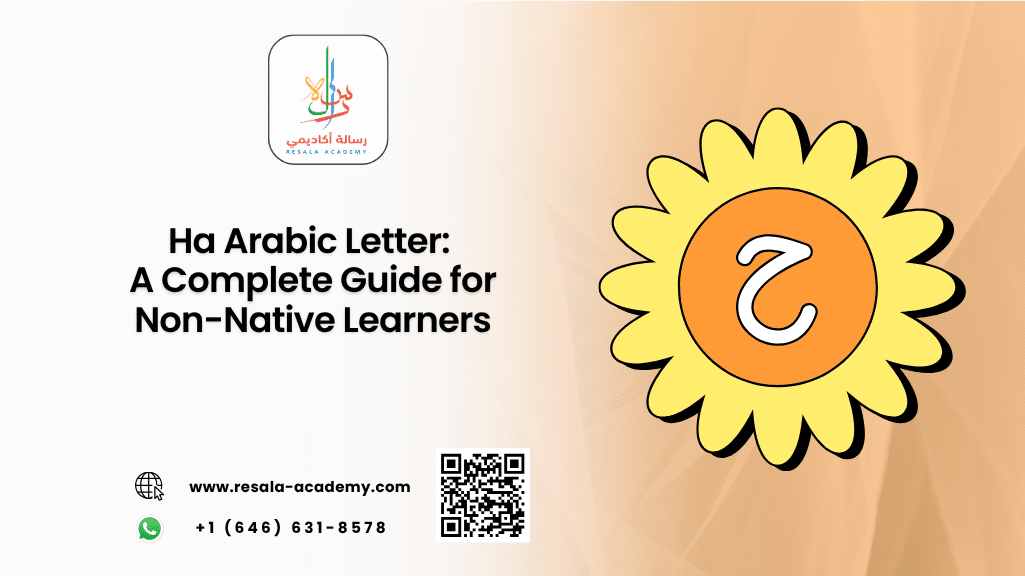Table of Contents
Ha Arabic Letter: A Complete Guide for Non-Native Learners
The Arabic language is a treasure trove of rich phonetics, unique script, and deep cultural significance. Among its 28 letters, the Ha Arabic letter (ح) stands out due to its distinct pronunciation and multifaceted usage. For non-native speakers, mastering this letter is crucial to achieving fluency and understanding the nuances of Arabic communication.
In this comprehensive guide, we’ll explore the Ha Arabic letter, its pronunciation, usage in context, and how learners can master it with the help of expert-led platforms like Resala Academy, a leading institution offering Arabic and Quran courses tailored for non-native speakers.
Introduction to the Arabic Alphabet
The Arabic script is written from right to left and consists of 28 letters. Each letter can take different forms depending on its position in a word—initial, medial, final, or isolated. Arabic is a Semitic language, and its alphabet is used in many languages, including Persian, Urdu, and Pashto.
Understanding each letter’s unique sound and shape is essential for reading, writing, and speaking Arabic fluently. One such letter that often challenges learners is “Ha” (ح).
What is the Ha Arabic Letter?
The Ha Arabic letter, written as ح in its isolated form, is the sixth letter of the Arabic alphabet. It is a voiceless pharyngeal fricative, which means it is produced deep in the throat without vocal cord vibration.
Key Facts:
- Arabic Name: حاء (Ḥāʾ)
- Position in Alphabet: 6th
- Phonetic Sound: /ħ/
- Transliteration: Commonly represented as “ḥ” or “h” with a dot underneath to distinguish it from ه (another Arabic letter pronounced as a soft “h”).
This letter is not to be confused with ه (Ha), which is a lighter, more breathy sound similar to the English “h”.
Pronunciation Guide: How to Say “Ha”
The pronunciation of ح (Ha) is one of the most challenging aspects for non-native speakers, especially those whose native languages lack pharyngeal sounds.
How to Pronounce ح:
- Open your throat slightly.
- Push air through the pharynx (the area behind your tongue and above your vocal cords).
- Do not use your vocal cords—the sound should be breathy but deep.
Audio Resource:
You can listen to native pronunciation of the letter here for better understanding.
Different Forms of Ha in Arabic Script
Like all Arabic letters, Ha (ح) changes its shape depending on its position in a word:
| Position | Form | Example | Translation |
|---|---|---|---|
| Isolated | ح | حبل | Rope |
| Initial | حـ | حليب | Milk |
| Medial | ـحـ | مفتاح | Key |
| Final | ـح | مريح | Comfortable |
Understanding these forms is essential for reading and writing Arabic fluently.
Examples of Words with Ha (ح)
To better grasp the usage of Ha, let’s explore some common Arabic words that include this letter:
- حب (ḥubb) – Love
- حرية (ḥurriyah) – Freedom
- حياة (ḥayāh) – Life
- صحيح (ṣaḥīḥ) – Correct
- مفتاح (miftāḥ) – Key
Each of these words carries significant meaning and is commonly used in everyday Arabic.
Common Mistakes by Non-Native Speakers
Many learners confuse ح (Ha) with other similar letters due to their unfamiliarity with Arabic phonology.
Common Confusions:
- ح (Ha) vs ه (Ha’): The former is a deep pharyngeal sound, while the latter is a soft glottal “h”.
- ح vs خ (Kha): Kha is a voiceless velar fricative, pronounced further back in the throat with a raspy sound.
Tips to Avoid Mistakes:
- Practice with native speakers or qualified tutors.
- Use audio resources to mimic pronunciation.
- Record your voice and compare it to native pronunciation.
Tips to Master the Ha Letter
Mastering the Ha Arabic letter requires consistent practice and the right learning strategy. Here are some expert tips:
Practice Techniques:
- Use Flashcards: Write the letter in all its forms and associate it with images.
- Listen & Repeat: Use audio tools like YouTube.
- Write Daily: Practice writing sentences that include ح to reinforce muscle memory.
- Enroll in Structured Courses: Platforms like Resala Academy offer guided lessons with native instructors.
Read more about: Arabic Letters in the Beginning Middle and End: A Visual Learning Toolkit for Non-Native Speakers
Resala Academy: Your Gateway to Arabic Fluency
Resala Academy is a renowned online institution that specializes in teaching Arabic and Quran to non-native speakers. Whether you’re a beginner or an advanced learner, Resala offers a structured, interactive, and culturally rich learning experience.
Why Choose Resala Academy?
✅ Native Arabic-speaking instructors
✅ Flexible online classes
✅ Tailored curriculum for non-native learners
✅ Quranic Arabic and Modern Standard Arabic courses
✅ Affordable pricing and trial classes
Thousands of students worldwide trust Resala Academy to help them achieve fluency in Arabic and deepen their understanding of Islamic teachings.
Linguistic Significance of the Ha Arabic Letter in Classical and Modern Arabic
The ha Arabic letter (ح) holds a unique place in both classical and modern Arabic, not only in phonetics but also in morphology and semantics. Understanding its role across different contexts enhances a learner’s grasp of Arabic structure and vocabulary.
Root Letter in Semitic Morphology:
▪️ In Arabic triliteral roots, ح often appears as a core consonant, influencing the meaning of entire word families.
▪️ Example: The root ح-ب-ب generates words like محبة (affection), محبوب (beloved), and حب (love).
▪️ Mastery of this letter helps learners decode and recognize patterns in Arabic word formation.
Presence in Grammatical Structures:
▪️ ح is frequently used in verbal forms such as Form I and Form II verbs (e.g., حمد – to praise, حطم – to smash).
▪️ Recognizing the ha Arabic letter in verb conjugations aids in parsing complex sentence structures in both spoken and written Arabic.
▪️ It also appears in nominal derivations, making it essential for learners aiming to expand their vocabulary efficiently.
Cognitive Benefits of Learning the Ha Arabic Letter for Non-Native Speakers
Acquiring proficiency in articulating and recognizing the ha Arabic letter offers more than just linguistic accuracy—it also contributes to cognitive development and auditory discrimination skills, especially for learners from non-Semitic language backgrounds.
Enhanced Phonemic Awareness:
▪️ Training to distinguish ح from similar sounds like ه and خ sharpens auditory processing.
▪️ This skill is transferable to learning other phonetically rich languages, giving learners a cognitive edge.
Improved Memory Retention:
▪️ Memorizing vocabulary that includes the ha Arabic letter engages both visual and auditory memory.
▪️ Example: Associating the word حرارة (ḥarārah – heat) with its context (weather, health) reinforces semantic memory.
Cultural and Religious Insight:
▪️ Many Arabic expressions and Quranic terms contain ح, such as الرحيم (Ar-Raḥīm – The Merciful), deepening learners’ understanding of Islamic texts.
▪️ This makes mastering the ha Arabic letter not only a linguistic goal but also a bridge to cultural literacy and spiritual enrichment.
These advanced insights into the ha Arabic letter provide learners with a well-rounded perspective, empowering them to navigate Arabic with confidence and precision.
Unlock the Power of Arabic with Resala Academy
Are you ready to master the Ha Arabic letter and dive deeper into the beauty of the Arabic language? Join thousands of learners who have transformed their language skills with Resala Academy’s Arabic Course online.
Whether you want to understand the Quran, converse with native speakers, or explore Arab culture, Resala Academy is your trusted partner. Don’t wait—enroll now and start your Arabic journey today!
FAQs
1. What is the difference between ح and ه in Arabic?
Answer: ح (Ha) is a deep, voiceless pharyngeal fricative, while ه (Ha’) is a soft, breathy “h” sound similar to the English “h”. They are pronounced from different parts of the throat and carry different meanings in words.
2. Is the letter Ha used in the Quran?
Answer: Yes, the letter ح appears frequently in the Quran. For example, in the word الرحمن (Ar-Raḥmān), meaning “The Most Merciful”, the letter ح is central. Understanding its pronunciation is essential for proper Quranic recitation.
3. How can I practice the Ha sound effectively?
Answer: Use audio tools, mimic native speakers, and practice with tutors. Resala Academy offers pronunciation-focused lessons that help learners master difficult sounds like ح.
4. Is Ha a common letter in Arabic?
Answer: Yes, it is very common and appears in many frequently used words such as حب (love), حياة (life), and حرية (freedom). Mastery of this letter is crucial for both conversational and formal Arabic.
5. Can children learn the Ha letter easily?
Answer: With the right guidance and resources, children can learn it effectively. Resala Academy offers child-friendly Arabic courses that include phonetics, writing, and interactive exercises to make learning fun and effective.
Conclusion
The Ha Arabic letter (ح) is more than just a character in the Arabic alphabet—it’s a gateway to understanding the depth and beauty of the Arabic language. While it may pose a challenge for non-native speakers, with the right tools and expert guidance, mastering it is entirely achievable.
Platforms like Resala Academy provide the structured learning environment necessary to conquer such challenges. Whether your goal is to speak Arabic fluently, read the Quran with precision, or simply explore a new language, Resala Academy is here to guide you every step of the way.
Ready to master Arabic one letter at a time? Start your journey with Resala Academy today.




